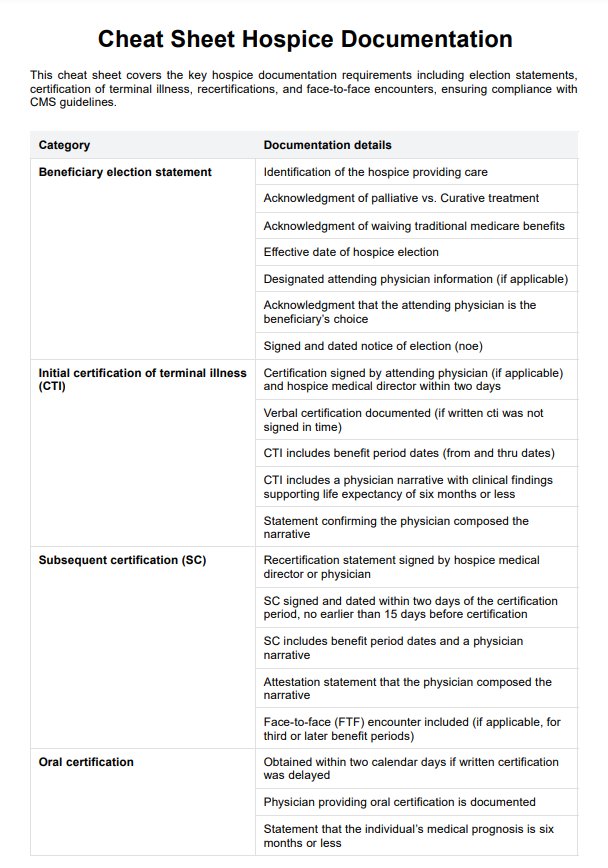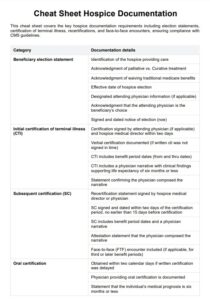Navigating the world of hospice care involves providing compassionate support to patients and their families during a sensitive time. Central to this care is the Interdisciplinary Team (IDT), a collaborative group of professionals who work together to develop and implement a personalized care plan. Accurate and comprehensive documentation is essential for ensuring continuity of care, meeting regulatory requirements, and facilitating effective communication within the IDT. This is where a well-structured hospice IDT documentation template becomes invaluable.

But let’s be honest, paperwork can sometimes feel overwhelming, especially when you’re focused on providing comfort and support. That’s why having a clear and organized hospice IDT documentation template can be a game-changer. It streamlines the process, ensuring that all essential information is captured consistently and efficiently. Think of it as a roadmap, guiding the IDT through each step of the care planning process, from initial assessment to ongoing evaluation and revision.
In this article, we will explore the importance of effective IDT documentation in hospice care and how a thoughtfully designed template can improve the quality of care, enhance communication, and simplify the administrative burden. We’ll delve into the key components of an effective template, discuss best practices for documentation, and provide practical tips for implementation. Ultimately, our goal is to empower you with the knowledge and resources you need to provide the best possible care for your patients and their families.
The Importance of Comprehensive IDT Documentation in Hospice Care
Why is comprehensive IDT documentation so vital in hospice? Well, for starters, it serves as the official record of the patient’s care plan and the decisions made by the interdisciplinary team. This record is crucial for ensuring that all members of the team are on the same page and that the patient’s needs are being met in a coordinated and consistent manner. Imagine trying to coordinate care without a clear understanding of the patient’s goals, medical history, or current condition. It would be like trying to navigate a maze blindfolded.
Beyond internal communication, accurate documentation is also essential for regulatory compliance. Hospice agencies are subject to strict regulations and audits, and documentation is a key component of demonstrating adherence to these standards. A well-documented care plan provides evidence that the hospice is providing appropriate and necessary care, and that the patient’s rights are being protected. Failing to maintain accurate and complete records can result in penalties, fines, or even loss of accreditation.
Furthermore, good documentation supports quality improvement initiatives. By tracking patient outcomes, identifying trends, and analyzing documentation, hospice agencies can identify areas where they can improve their care processes. This continuous improvement cycle is essential for ensuring that the hospice is providing the highest quality of care possible. Think of it as a feedback loop, where documentation provides valuable insights that can be used to refine and enhance the care provided.
Moreover, complete and accessible documentation empowers the hospice team to provide truly personalized care. When all relevant information is readily available, team members can make informed decisions about the patient’s care, anticipate potential problems, and respond quickly to changing needs. This individualized approach is at the heart of hospice care, and it is made possible by effective documentation practices.
Ultimately, the purpose of hospice care is to provide comfort, dignity, and support to patients and their families during a challenging time. Comprehensive IDT documentation is not just an administrative task; it is an integral part of providing that care. It ensures that the patient’s voice is heard, that their needs are met, and that their wishes are respected. The right hospice idt documentation template will facilitate the workflow needed to capture all data.
Key Elements of an Effective Hospice IDT Documentation Template
Now that we’ve established the importance of comprehensive documentation, let’s explore the key elements that should be included in a well-designed hospice IDT documentation template. First and foremost, the template should be user-friendly and intuitive. It should be easy for all members of the IDT to understand and use, regardless of their level of technical expertise. A clear and organized layout, with consistent formatting and terminology, can go a long way in promoting accuracy and efficiency. Consider that the template is not only an input data tool, but also an output that will be read by other people.
The template should also include all the essential information required for a comprehensive care plan. This typically includes patient demographics, medical history, current medications, psychosocial assessment, spiritual assessment, goals of care, interventions, and evaluation of outcomes. It’s important to have dedicated sections for each of these areas, with clear prompts and instructions to guide the user. It is important to also include patient and family input in the template.
Another key element of an effective template is flexibility. While it’s important to have a standardized format for consistency, the template should also allow for customization to meet the unique needs of each patient. This might involve adding additional sections, modifying existing sections, or using free-text fields to capture specific details. The ability to tailor the template to the individual patient ensures that the care plan is truly personalized.
Incorporating prompts for risk assessments is also essential. This includes areas such as risk for falls, skin breakdown, medication side effects, and psychosocial distress. Identifying these risks early allows the IDT to implement preventative measures and minimize potential complications. This is important for patient safety and also helps to improve the overall quality of care.
Finally, an effective hospice IDT documentation template should be designed to facilitate ongoing communication and collaboration among members of the IDT. This might involve features such as electronic signatures, automated notifications, and secure messaging. The template should also be integrated with other electronic health record (EHR) systems to ensure seamless data sharing and prevent duplication of effort. The ultimate goal is to create a documentation system that supports efficient and effective teamwork, leading to better outcomes for patients and their families.
With diligent and precise documentation, hospice staff can better understand the patient’s conditions.
The patient benefits when the IDT is provided with a good documentation template.



